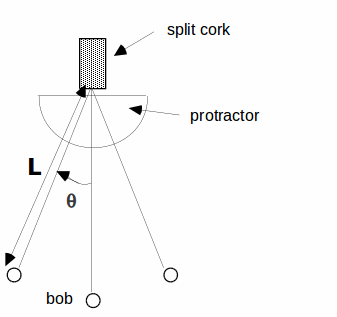Apparatus:
Cotton thread, small pendulum bob, protractor, split cork, metre ruler, stopwatch, piece of card with a drawn line, retort stand/clamp/boss.
Diagram:

Procedure:
1. Set up a small simple pendulum, as shown in the diagram.
2. Keeping the angle of swing,![]() less than 10 , for at least 8 lengths of the pendulum,
less than 10 , for at least 8 lengths of the pendulum,![]() between
between
20cm and 100cm, measure the period of swing,![]() (see 'Timing Swings' below).
(see 'Timing Swings' below).
3. Plot a graph of![]() against
against![]()
4. For a small angle![]() where
where![]() is the acceleration due to gravity. The gradient of your graph is equal to
is the acceleration due to gravity. The gradient of your graph is equal to![]() Measure your gradient and use it to calculate a value of
Measure your gradient and use it to calculate a value of![]()
5. Estimate the uncertainty in your result.
6. Explain why the gradient of your graph is equal to![]()
7. For one of the lengths you used in stage 2 investigate how (if at all) the period of oscillation,![]() varies if the initial angle of oscillation is increased to at least 90 °.
varies if the initial angle of oscillation is increased to at least 90 °.
Timing Swings:
At the end of a swing the bob is stationary for a brief instant before swinging back again. It is therefore difficult to identify the precise instant of the end of a swing since the bob is far out for a long time. At the centre of the swing the bob is moving rapidly, and the instant that it passes the central point is more precisely defined. Technically timing the swings from the central position is better. It is common to use a mark to assist in identifying the instant when the bob passes the centre position (e.g. a line on a piece of card). To find the time of one swing you should time a number of swings so that the total time taken is at least 30 seconds and you should repeat this measurement at least once more.
